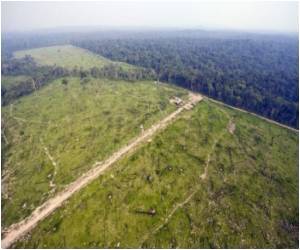A new NASA research has found that humans are consuming an increasing amount of the earth's total annual land plant production.

A NASA research group led by Marc Imhoff at NASA's Goddard Space Flight Center, Greenbelt, first quantified this global consumption in 2004, when the group found that in 1995 humans consumed 20 percent of all the land plant material produced that year.
Now the same line of research has produced a multi-decadal record of plant production (from 1982 to 2007) that establishes a baseline of the Earth's productivity, and a 10-year trend of human consumption.
Some of the most notable findings from the research include:
From 1995 to 2005, human consumption of land plants rose from 20 percent to 25 percent of the total plant production of each year. Imhoff said scientists think this is a significant rise for that period of time, but that part of the challenge of this research is determining the uncertainties in the measurement, the limits of ecosystems' production and the impacts of a rising consumption rate.
Both total, global consumption and per capita consumption are rising.
Advertisement
Great regional discrepancies remain. The average person in North America consumes about 6 tons of plant-based carbon each year, while the average person in Southeast Asia consumes just less than 2 tons of plant-based carbon each year.
Advertisement
While plant production itself varies from year to year, mostly depending on weather, the demand trends are holding steady on the increase. Depending on region, some of the increase is due simply to population growth - more people consume more food, more paper, more wood for burning.
This has been seen in places like India, where population is booming but individual consumption levels have not dramatically risen, yet. In other places, where economic growth has allowed for more "westernized" consumption, per capita consumption is driving the trend. And in some places, such as North America, both population and per capita consumption are increasing.
The research group's 1982-2009 plant production data - called "net primary production," or NPP, in the science literature - is provided by NASA satellite instruments, first from Advanced Very High-Resolution Radiometer (AVHRR) sensors and in more recent years from Moderate-Resolution Imaging Spectroradiometer (MODIS).
The scientists analyzed the consumption data from the U.N. Food and Agriculture Organization's country profiles.
"The global demand is going up," Imhoff said.
"We've gone from 20 percent demand to about 25 percent demand in 10 years. People worry about that percentage. If, in future scenarios, it's going to go up to something like 50 percent, we're looking at a very high demand for land management to maximize productivity at all levels on the landscape and at the expense of all other uses, for example, carbon sequestration, habitat, or water storage. We would be heading toward a place where the planet would be very carefully managed, from end to end," Imhoff added.
These new findings have been presented at the American Geophysical Union's Fall Meeting in San Francisco, Calif.
Source-ANI


![Genetically Modified Food / Genetically Modified Organism [GMO] Genetically Modified Food / Genetically Modified Organism [GMO]](https://images.medindia.net/patientinfo/120_100/Genetically-Modified-Food.jpg)






